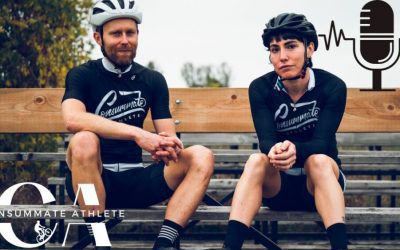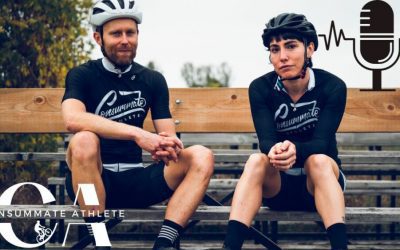Today, we are very fortunate to have Katy Bowman on the podcast. Katy is a biomechanist, with emphasis on the BIO because rather than looking only at isolated joint angles, Katy has specialized in looking at how our movement, or lack thereof, influences all parts of our lives as well as our families, communities and the environment Katy’s work suggests we can, and should, be careful allowing technology the chance to remove all labor from our days. She has written numerous articles, 5 books and recorded multiple podcasts on her concept, nutritious movement. Katy’s latest book Movement Matters is available on Amazon now and it is a fantastic read that nudges you to get moving and provides many examples of why your movement throughout the day matters whether you are an athlete, a parent or struggling to find health.
Download on Itunes (subscribe & leave a review Please!)
Download Android / Stream / Listen online
Download and view on Wide-Angle-Podium Site
Social / links
Questions
- not an active person in childhood
- runner at 18
- by college, she was personal trainer, runner, 4-5hrs of training per day (mostly endurance)
- 1st race at 22, 5k doing 7.5 min miles very casually
- started triathlon with a borrowed bike (“thought it would be fun”)
- athletic career = when engaging in exercise for solely physical accomplishment
- still doing big things, i.e on her birthday, does something to do with the number, i.e a 40 mile walk for her 40th birthday
- “I like treks that have a sense of accomplishment versus mileage alone”
- didn’t realize movement existed outside of exercise
- started to define difference between exercise and movement
- movement = anything you do with your body
- exercise = specific motion for physical adaptation
- ex: if you’re climbing a tree for exercise so you can improve core vs. climbing tree for apple picking, the purpose is different (movement is byproduct of getting something you need)
- exercise: movement happening outside of everything else in your life
- moving: any movement with physical benefit but other stuff being facilitated
- nutritious movement = movement and diet are similar. there are movement nutrients similar to needing a spectrum of foods to make cells operate properly. nutritional deficiency comes when missing certain nutrients. similarly, movement deficiencies can happen even with a good but not varied ‘diet’ of movement, and you’ll be depleted in certain areas. also, too much of the same movement/nutrient can be too much and be toxic to the system
- movement malnutrition: nothing at all, or just doing the same thing over and over again (ie cycling and then just lying around / being sedentary)
- there are parts we use all the time and parts we never use. ex: cyclists use legs in one particular way, but cyclist might see bone density loss in local parts of legs that aren’t being used. “Just because some whole body measures are getting better doesn’t mean every cell is getting that benefit.”
- no matter who you are, you need to look at biomechanical inputs through the day
- athletic people don’t differ on paper much from those 0 exercise people: 60 min of exercise or not isn’t that different. That’s only 4% of your day!
- you have hours to move more, but you need to think of movements you aren’t doing for fun/athletics
- look at time that isn’t exercise for where you can add movement
Links to to help you get walking
=> link to proper gait https://nutritiousmovement.com/gait-101/
Stacking for the athlete training several hours
- stacking = working movement into non-workout time
- we mostly choose sedentary form of tasks, i.e running errands in the car, sitting down in restaurant to hang out with people
- making sedentary choices
- stacking example: Katy & husband are into athletics, but hit athletic wall/time crunch when had kids. Had date night, but decided to change it to a movement-focused date hike instead. “Sedentarism and romantic connection don’t have to go hand in hand.”
- Movement improves quality of time
- Expand idea of how a task can be accomplished
- “We all have to be productive, we have to work, but there’s nothing that says my laptop only works when my butt is in a chair.”
- Movement doesn’t have to be intense or extreme. Can be exhausted, but don’t have to flop on the couch—can rest in dynamic way, i.e sitting on the floor
- mobility doesn’t have to be just for physical benefit and need not be a solo, blocked out hour of your day. Sitting on floor to work is very similar to movements you would do in a mobility ‘session’
- when you stop trying to ‘step out’ of your life to get more exercise, you become a better athlete
- choose to continue to do the sport
- when exercise is sole movement for the day, you’re adapting to what you do with greatest amount of force. if you’re sitting around after cycling, your foot doesn’t get used to walking on spread out, well-aligned feet
- need to increase time on feet (walking) in wider shoes, and make sure no other shoes look like those shoes. don’t wear tight shoes the rest of the time. train your feet to offset that cumulative adaptation that your sport brings about
- Rock climbing to high heels trains muscles to stay together all the time, can cause foot/knee/hip issues
- where are you spending the bulk of your time (home, office, walking, etc.) and choose a shoe with wider toe box/go barefoot when possible
- do corrective foot exercises (form and technique is important)
- great sport form but poor other form means you’re adapting to other form since not exercising bulk of the day
- add different surfaces to walk (move more of you!), move in a variety of ways, not just flat cement (work gradually)
- you can run whenever you can run
- don’t need to consume a ton of running, but need to be moving
- consider how your body feels, what’s working, what’s wrong, how you’re trying to continue running versus shifting physical structure (i.e ibuprofen, braces, etc.)
- look for clear signs that current behaviors aren’t sustainable.
- don’t need to increase workout, need to decrease sedentary behavior (don’t reduce working out, just add walking. If you want to wear fit/healthy label, you have to earn it)
- Read Move Your DNA (link below)
- You’re adapted to sitting. Then, athletic event, usually linear with hips, spine, etc. (not a lot of rotation happening)
- Sleep, we have created a situation with soft mattresses/pillows. But people should transition away from comfortable beds/mattresses.
- If you’re coddled in soft mattress all night, you stay in 1 position similar to how you sit all day. Movement should even happen in sleep!
- Can you lie flat on the floor before bed, and then repeat that in bed so you’re not automatically in that seated position
- less cushion, the more your positions while you sleep vary more naturally
- no one ultimate position, but should be able to sleep anywhere in wide range of positions
- consider sleep like crosstraining – moving / posturing in different ways
- NOTE: it took 18 months for Katy to transition away from a pillow so that she was not sleeping with head forward and this helped reduce or remove neck pain and headaches she fought for years. *tall pillows push head forward of midline alignment in same fashion as we do all day to look down at phones (or garmins on your bike!)
- signing in Victoria This Thursday November 17th https://nutritiousmovement.frontdeskhq.com/courses/96080
- new book is out and a best seller! : Movement Matters! (If you could move more, it won’t just make your physiology better, it’ll make your life better.)
- virtual classes on nutritious movement & transitioning to minimal shoes/floor-sitting/walking/general lifestyle changes as someone who’s mostly sedentary.




